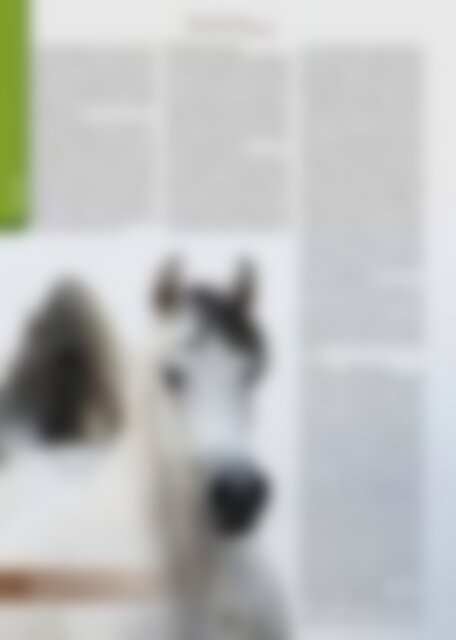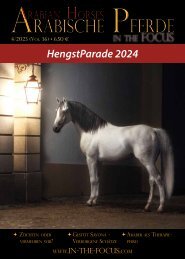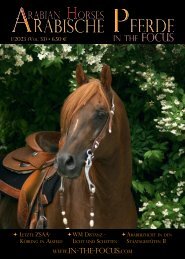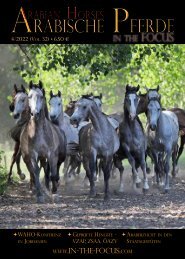Arabische Pferde IN THE FOCUS 4/2020 (Vol. 24) - public
Zeitschrift für Liebhaber und Züchter Arabischer Pferde
Zeitschrift für Liebhaber und Züchter Arabischer Pferde
Sie wollen auch ein ePaper? Erhöhen Sie die Reichweite Ihrer Titel.
YUMPU macht aus Druck-PDFs automatisch weboptimierte ePaper, die Google liebt.
Zucht<br />
means that emphasis must also be placed<br />
on maintaining those lines that do not correspond<br />
to current fashion - and this fashion<br />
today means the "ideal", shaped by the Saklawi-I<br />
line. Another guiding principle is that<br />
beauty and functionality are not excluding<br />
each other, but where breeders only focus<br />
on beauty, functionality is lost - and that is a<br />
path of no return.<br />
Philippe Paraskevas did not have this awareness<br />
from the beginning. He started his original<br />
breeding program without a clear vision<br />
of where it would lead. It took time until<br />
he developed a breeding alternative to the<br />
mainstream, but then he began to collect<br />
the best specimens of some rare bloodlines<br />
and started to breed with them - always in<br />
an effort to preserve their peculiarities. He<br />
has thus dedicated himself to preservation<br />
breeding in the truest sense of the word, including<br />
- or above all - the preservation of<br />
non-commercial lines that are easily lost in<br />
a market-oriented environment.<br />
Preserving Sire Lines<br />
Today Philippe Paraskevas is probably the<br />
only breeder, alongside El Zahraa, the Egyptian<br />
state stud, who maintains all three Egyptian<br />
sire lines. However, he maintains them<br />
with a different focus than the state stud,<br />
where around two thirds of the stallions belong<br />
to the Saklawi-I line, a line that has supplanted<br />
the Gamil El Kebir and above all the<br />
El Deree lines worldwide. Here at Paraskevas,<br />
these last two lines are particularly well looked<br />
after, the Saklawi I line he recently added<br />
for the sake of completeness.<br />
The Gamil-El-Kebir line split into two branches<br />
at the beginning of the 20th century via<br />
the two stallions Ibn Samhan and Ibn Rabdan.<br />
Paraskevas’ chief sire Ghallab El Ateya<br />
(Rizkallah / Shameya) * 2002 belongs to this<br />
latter line via Ibn Rabdan. He was shown to<br />
us proudly ridden by Maarouf Sirhan, the<br />
trainer, during our visit. Ghallab goes back to<br />
Anter, who became known in Germany as the<br />
sire of Gharib. According to Paraskevas, this<br />
line is characterized by excellent riding characteristics<br />
and above-average movements.<br />
They are rather strong, rounded horses with a<br />
lot of girth depth – so, the long-lined, elegant<br />
Gharib clearly falls out of the role and is probably<br />
more like his dam Salwa in conformation.<br />
Ghallab’s most important son at the stud<br />
is Shaer Al Nile, who is ridden for us by 12-year-old<br />
Ziad, a grandson of Hammad Rabeii.<br />
Also, Shaer Al Nile is “round” like his sire, but<br />
his face is a bit more “modern”. We are also<br />
introduced to a Ghallab great-grandson, the<br />
three-year-old Tag Al Ola (by Shaer Al Nile) in<br />
which the extremely large nostrils are noticeable<br />
when in motion, which gives the face a<br />
lot of nobility. Apart from that, he stands in a<br />
square format and is characterized by a good<br />
top line and correct legs, he also knows how<br />
to carry himself in motion. As a highlight, the<br />
Ghallab son Faress El Ahlam and the grandson<br />
Gawad El Nile are ridden in front of us,<br />
this time as "dancing horses", as is traditional<br />
in Egypt. Both stallions are characterized by<br />
extremely strong hindquarters, which allow<br />
them to keep this piaff-like exercise for several<br />
minutes. We see a total of 12 descendants<br />
of Ghallab in the first to third generation and<br />
slowly we understand the description of this<br />
line given at the beginning.<br />
Now one might wonder why a breeder has 12<br />
stallions from the same line? Basically, they<br />
are a gene reservoir, because twice in the<br />
past Paraskevas had almost lost a sire line<br />
when the chief-sire died without a corresponding<br />
number of offspring to replace him.<br />
Paraskevas does not want to face this fate<br />
again - therefore he keeps a large number of<br />
stallions.<br />
Tahseed el Leil (Nahedd / Sehr El Leil Hoor)<br />
*2014 - damline / Stutenlinie El Kahila (Kohailan<br />
Krush)<br />
14<br />
El Deree – the Outcross<br />
The second sire line of Paraskevas is that of El<br />
Deree. This line is only represented by five (of<br />
31) stallions in El Zahraa (see AP 1/<strong>2020</strong>, p.<br />
12), in Germany it was once present through<br />
Morhaf, but is now completely extinct here.<br />
El Deree was a "desert-bred" and he was a<br />
superior racehorse, bred by a Bedouin tribe<br />
in the Al Jazirah (Syria) and thus has a different<br />
origin than most of the other horses of<br />
the EAO / RAS / Inshass, many of which came<br />
from Saudi Arabia. This makes him an ideal<br />
"outcross”. El Deree set himself a monument<br />
with his son Sid Abouhom, whose daughters<br />
Lubna, Mouna and Mabrouka out of<br />
the legendary Moniet El Nefous brought her<br />
dam line to world fame. Today the El Deree<br />
line always goes via Akthal, and so the two<br />
Paraskevas stallions Zay Al Hawa and Sawwah<br />
go via Ibn Akhtal, while Ala Baly traces<br />
via Ibn Akthals half-brother Aybac back to El<br />
Deree. Zay Al Hawa inspires me with his clearly<br />
contoured muscles - the racehorse from<br />
back then really seems to shine through. And<br />
the legs, too, are dry like in a desert-bred. Ala<br />
Baly shows perhaps more overall harmony in<br />
his body, while he was presented to us very<br />
dynamically under the saddle.<br />
To complete the stallions, representatives of<br />
the Saklawi I line also found their way into<br />
© ARABISCHE PFERDE - <strong>IN</strong> <strong>THE</strong> <strong>FOCUS</strong> 4/<strong>2020</strong>
















